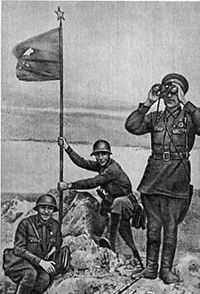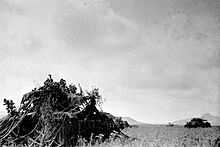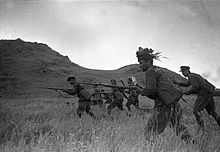Battle of Lake Khasan
| Battle of Lake Khasan | |||||||||
|---|---|---|---|---|---|---|---|---|---|
| Part of the Soviet-Japanese Border Wars | |||||||||
 Lieutenant I.N. Moshlyak and two Soviet soldiers on Zaozyornaya Hill after the battle[1][2] | |||||||||
| |||||||||
| Belligerents | |||||||||
|
|
| ||||||||
| Commanders and leaders | |||||||||
|
|
| ||||||||
| Strength | |||||||||
| 22,950 | 7,000–7,300[5] | ||||||||
| Casualties and losses | |||||||||
| 236 killed, 611 wounded[6] | 526 killed, 913 wounded | ||||||||
| ||||||
The Battle of Lake Khasan (July 29, 1938 – August 11, 1938) and also known as the Changkufeng Incident (Russian: Хасанские бои, Chinese and Japanese: 張鼓峰事件; Chinese Pinyin: Zhānggǔfēng Shìjiàn; Japanese Romaji: Chōkohō Jiken) in China and Japan, was an attempted military incursion by Manchukuo (Japanese) into the territory claimed by the Soviet Union. This incursion was founded in the belief of the Japanese side that the Soviet Union misinterpreted the demarcation of the boundary based on the Treaty of Peking between Imperial Russia and the Qing Dynasty China (and subsequent supplementary agreements on demarcation), and furthermore, that the demarcation markers were tampered with.
Background
For most of the first half of the twentieth century there was considerable tension between the Russian (later Soviet), Chinese and Japanese governments along their common borders in what is now North East China. The Chinese Eastern Railway or (CER) was a railway in northeastern China (Manchuria). It connected China and the Russian Far East. The southern branch of the CER, known in the West as the South Manchuria Railway, became the locus and partial casus belli for the Russo-Japanese War and subsequent incidents leading to the Second Sino-Japanese War, and a series of Soviet-Japanese Border Wars. Larger incidents included the Sino-Soviet conflict of 1929 and the Mukden Incident between Japan and China in 1931. The battle of Lake Khasan was fought between two powers which had long mistrusted each other.
The confrontation was triggered when the Soviet Far East Army and Soviet State Security (NKVD) Border Guard reinforced its Khasan border with Manchuria. This was prompted in part by the famous defection one month before of Soviet General G.S. Lyushkov, in charge of all NKVD forces in the Soviet Far East at Hunchun, located in the heart of the Tumen River Area. He provided the Japanese with critical intelligence on the poor state of Soviet Far Eastern forces and the wholesale purge of army officers.[7]
Events

On July 6, 1938 the Japanese Kwantung Army intercepted and decoded a message sent by the Russian commander in the Posyet region to Soviet headquarters in Khabarovsk. The message recommended that Russian soldiers be allowed to secure previously unoccupied high ground west of Lake Khasan, most notably the disputed Changkufeng Heights, because it would be advantageous for the Soviets to occupy terrain which overlooked the Korean port-city of Rajin, as well as strategic railways linking Korea to Manchuria.[8] Within the next two weeks, small groups of Soviet border troops then moved into the area and began fortifying the mountain, constructing emplacements, observation trenches, entanglements, and communications facilities.
At first, the Japanese Korean Army, which had been assigned to defend the area, disregarded the Soviet advance. However, the Kwantung Army, whose administrative jurisdiction overlapped Changkufeng, pushed the Korean Army to take more action because it was suspicious of Soviet intentions. Following this, the Korean Army took the matter to Tokyo, recommending that a formal protest be sent to the USSR.
The conflict started on July 15, when the Japanese attaché in Moscow demanded the removal of Soviet border troops from the Bezymyannaya (сопка Безымянная, Chinese name: Shachaofeng) and Zaozyornaya (сопка Заозёрная, Chinese name: Changkufeng) Hills to the west of Lake Khasan in the south of Primorye, not far from Vladivostok, claiming this territory by the Soviet–Korea border. The demand was rejected.

The first Japanese attack on July 29 was repelled, but on July 31 the Soviet troops had to retreat. The Japanese 19th Division along with some Manchukuo units took on the Soviet 39th Rifle Corps under Grigori Shtern (eventually consisting of the 32nd, 39th, and 40th Rifle Divisions, as well as the 2nd Mechanised Brigade).[9] One of the Japanese Army Commanders at the battle was Colonel Kotoku Sato, the commander of the 75th Infantry Regiment. Sato's forces expelled Russian troops from the hill in a night sortie, the execution of which became a Japanese model for assaults on fortified positions.
It was also reported that during the Changkufeng Incident the Japanese orchestrated frontal assaults with light and medium tanks which were immediately followed by Russian tank and artillery counter-attacks. In 1933, the Japanese designed and built a "Rinji Soko Ressha" (Special Armoured Train). The train was deployed at "2nd Armoured Train Unit" in Manchuria and participated in the Second Sino-Japanese War and the Changkufeng conflict against the Soviets transporting thousands of Japanese troops to and from the battlefield, displaying to the West the capability of an Asian nation to adopt and implement Western ideas and doctrine concerning rapid infantry deployment and transportation.
On 31 July, People's Commissar for Defence Kliment Voroshilov ordered combat readiness for 1st Coastal Army; Pacific Fleet was mobilized as well.
The chief of the Far East Front, Vasily Blücher, arrived at the front line on August 2, 1938. Under his command additional forces were moved to the zone of conflict and after several engagements during August 2–9 the Japanese forces were disastrously defeated and thrown out of the Soviet territory.
On August 10, Japanese ambassador Mamoru Shigemitsu asked for peace and the hostilities ceased on August 11.[3][10]
Consequences
More than 6500 Soviet officers and soldiers were awarded the orders, decorations, and medals of the Soviet Union[11] (26 of them were awarded the title Hero of the Soviet Union,[3] and 95 were awarded the Order of Lenin[12]).
The Soviet losses were blamed on the incompetence of Vasily Blücher. On October 22 he was arrested by the NKVD and later thought to have been tortured to death.[13]
The Japanese military, while seriously analyzing the results of the battle, would later engage with the Soviets once more, with disastrous results, in the more extensive Battle of Khalkhin Gol (Nomonhan) in the Soviet-Japanese Border War of 1939. This second engagement resulted in the defeat of the Japanese Sixth Army.
Following the end of World War II, at the International Military Tribunal for the Far East in 1946, thirteen high-ranking Japanese officials were charged with crimes against peace for their roles in initiating hostilities at Lake Khasan.[14]
See also
- Ivan Pozharsky, posthumously awarded Hero of the Soviet Union for his participation in the battle
References
- ↑ Хасанский конфликт // "Военно-исторический журнал", № 7, 2013 (последняя страница обложки)
- ↑ "Над Заозёрной - красный флаг Советского Союза... Этот флаг водрузил наш земляк, уроженец Алтайского края И.Н. Мошляк. Вскоре его грудь украсила Золотая Звезда Героя Советского Союза"
В пламени и славе. Очерки истории Краснознамённого Сибирского военного округа. / редколл., предс. Б. Е. Пьянков. 2-е изд., испр. и доп. Новосибирск, Новосибирское кн. изд-во, 1988. стр.61 - ↑ 3.0 3.1 3.2 Хасан // Советская военная энциклопедия (в 8 томах) / под ред. А. А. Гречко. том 8. М.: Воениздат, 1976. стр.366—367
- ↑ А. А. Кошкин. «Кантокуэн» — «Барбаросса» по-японски. Почему Япония не напала на СССР. М., «Вече», 2011.
- ↑ Alvin Coox, Nomonhan (Stanford University Press, 2003), p. 135
- ↑ General-Lieutenant G.F.KRlVOSHEYEV (1993). "SOVIET ARMED FORCES LOSSES IN WARS,COMBAT OPERATIONS MILITARY CONFLICTS" (PDF). MOSCOW MILITARY PUBLISHING HOUSE. p. 62. Retrieved 2013-11-23.
- ↑ Regional CO-Operation in Northeast Asia The Tumen River Area Development Program, 1990-2000: In Search of a model for regional economic co-operation in Northeast Asia
- ↑ Alvin Coox, Nomonhan (Stanford University Press, 2003), p124
- ↑ John Erickson (historian), The Soviet High Command, MacMillan & Co. Ltd, 1962, p.497–8
- ↑ А. А. Кошкин. «Кантокуэн» — «Барбаросса» по-японски. Почему Япония не напала на СССР. М., «Вече», 2011.
- ↑ Хасан // Советская историческая энциклопедия / редколл., гл. ред. Е.М. Жуков. том 15. М., государственное научное издательство "Советская энциклопедия", 1974. стр.543
- ↑ 50 лет Вооружённым силам СССР, 1918 — 1968. / редколл., отв. ред. М. В. Захаров. М., Воениздат, 1968. стр.219-220
- ↑ Great Russian Encyclopedia (2005), Moscow: Bol'shaya Rossiyskaya enciklopediya Publisher, vol. 3, p. 618.
- ↑ See count 25 of the IMTFE indictment, available at http://www.trumanlibrary.org/whistlestop/study_collections/nuremberg/documents/index.php?documentdate=0000-00-00&documentid=18-2&pagenumber=1
Bibliography
- Coox, Alvin D. The Anatomy of a Small War: The Soviet-Japanese Struggle for Changkufeng/Khasan, 1938. Westport, Conn.: Greenwood Press, 1977. ISBN 0-8371-9479-2
External links
- Soviet viewpoint map of Russian-Japanese Changkufeng/Lake Khasan Incident
- Topographic map of the Lake Khasan area
Coordinates: 42°26′09.26″N 130°36′39.62″E / 42.4359056°N 130.6110056°E